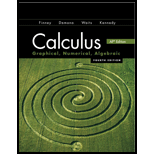
a.
To find:The time during which the particle moves forward, moves backward, speeds up and slows down.
a.
Answer to Problem 9E
The particle moves forward when
Explanation of Solution
Given Information:A figure showing the velocity
The particle moves forward when the velocity is positive, i.e., when
The particle moves backward when the velocity is negative, i.e., when
Now,
The particle speeds up when the slope of the graph of speed v/s time is positive, i.e., when
The particle slows down when the slope ofthe graph of speed v/s time is negative, i.e., when
b.
To find:The time during which the particle’s acceleration is positive, negative and zero.
b.
Answer to Problem 9E
The acceleration of the particle is positive when
Explanation of Solution
Given Information:A figure showing the velocity
The acceleration of the particle is positive when the slope of the given graph is positive, i.e., when
c.
To find:The time during which the particle is moving at its greatest speed.
c.
Answer to Problem 9E
The speed is greatest when
Explanation of Solution
Given Information:A figure showing the velocity
The speed is greatest when
d.
To find:The time during which the particle stands still for more than an instant.
d.
Answer to Problem 9E
The particle stands still for more than an instant when
Explanation of Solution
Given Information:A figure showing the velocity
From figure, it is clear that when
Chapter 3 Solutions
Calculus 2012 Student Edition (by Finney/Demana/Waits/Kennedy)
Additional Math Textbook Solutions
College Algebra with Modeling & Visualization (5th Edition)
Algebra and Trigonometry (6th Edition)
Thinking Mathematically (6th Edition)
University Calculus: Early Transcendentals (4th Edition)
College Algebra (7th Edition)
Elementary Statistics (13th Edition)
 Calculus: Early TranscendentalsCalculusISBN:9781285741550Author:James StewartPublisher:Cengage Learning
Calculus: Early TranscendentalsCalculusISBN:9781285741550Author:James StewartPublisher:Cengage Learning Thomas' Calculus (14th Edition)CalculusISBN:9780134438986Author:Joel R. Hass, Christopher E. Heil, Maurice D. WeirPublisher:PEARSON
Thomas' Calculus (14th Edition)CalculusISBN:9780134438986Author:Joel R. Hass, Christopher E. Heil, Maurice D. WeirPublisher:PEARSON Calculus: Early Transcendentals (3rd Edition)CalculusISBN:9780134763644Author:William L. Briggs, Lyle Cochran, Bernard Gillett, Eric SchulzPublisher:PEARSON
Calculus: Early Transcendentals (3rd Edition)CalculusISBN:9780134763644Author:William L. Briggs, Lyle Cochran, Bernard Gillett, Eric SchulzPublisher:PEARSON Calculus: Early TranscendentalsCalculusISBN:9781319050740Author:Jon Rogawski, Colin Adams, Robert FranzosaPublisher:W. H. Freeman
Calculus: Early TranscendentalsCalculusISBN:9781319050740Author:Jon Rogawski, Colin Adams, Robert FranzosaPublisher:W. H. Freeman
 Calculus: Early Transcendental FunctionsCalculusISBN:9781337552516Author:Ron Larson, Bruce H. EdwardsPublisher:Cengage Learning
Calculus: Early Transcendental FunctionsCalculusISBN:9781337552516Author:Ron Larson, Bruce H. EdwardsPublisher:Cengage Learning





